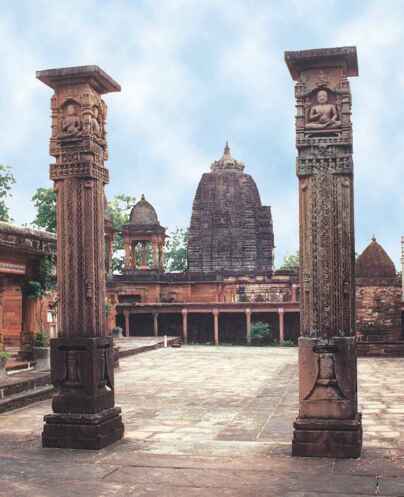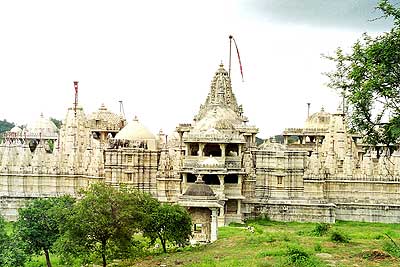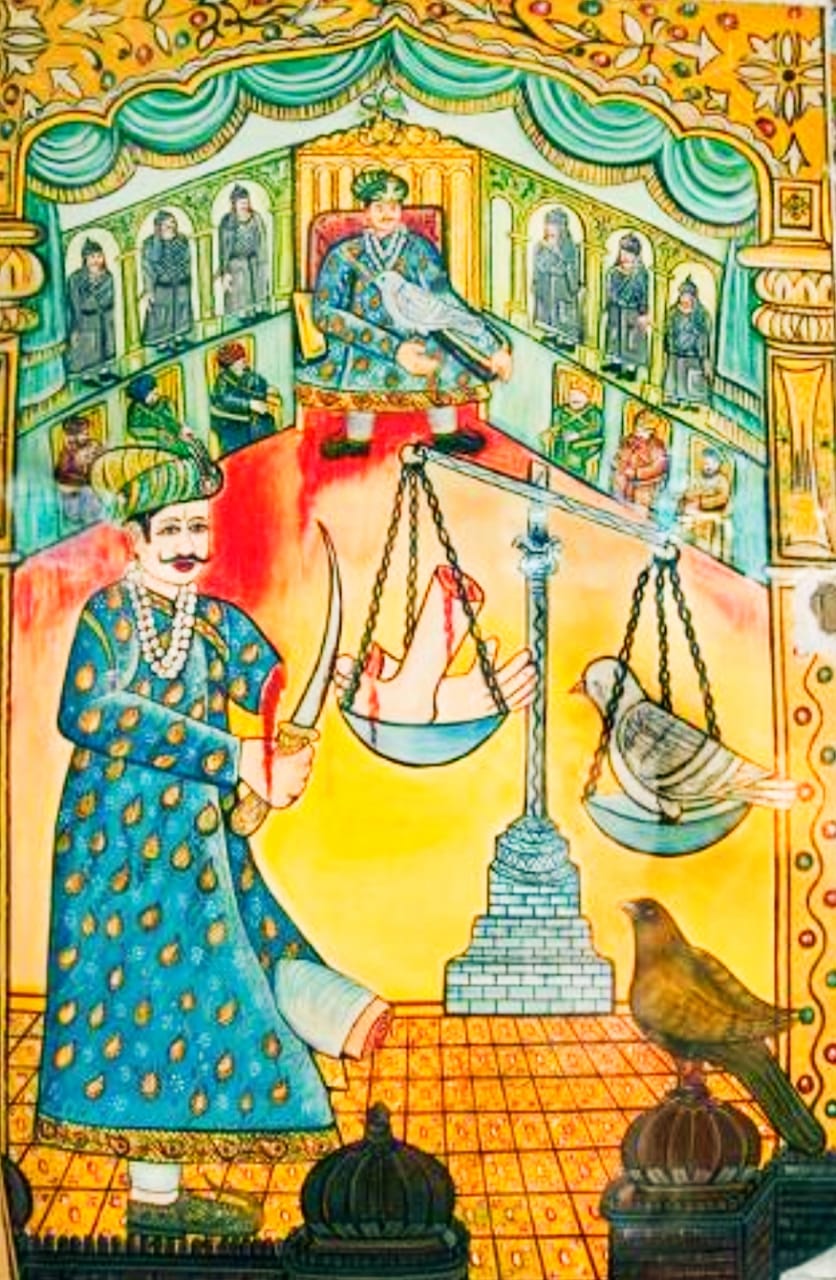|
Parwar (Jain Community)
Parwar, also spelt as Paravāra (परवार in Hindi, पौरपट्ट in Sanskrit inscriptions), is a major Jain community from the Bundelkhand region, which is largely in Madhya Pradesh, but also includes the two districts of Lalitpur and Jhansi in Uttar Pradesh. Apart from them, Nagpur district (Maharashtra) have also a very large Parwar community. There is an area in Itwari of Nagpur known as Parwar-Pura having large number of Parwar's homes and shops . Most of the Nagpur's Parwar are migrated from Sagar, Deori, and other small villages of Sagar District of MP. Parwar exclusively follow the Digambar Jain tradition. Parwar usually preferred their marriage within community. There are 12 Gotra in Parwar community. Each Gotra has 12 Moor (lineages). A marriage within the same gotra or lineage are not allowed. Traditionally a marriage within any of the 8 branches (the moor of boy or girl, mother's family, father's mother's family etc) was not permitted and hence the co ... [...More Info...] [...Related Items...] OR: [Wikipedia] [Google] [Baidu] |
Epigraphia Indica
''Epigraphia Indica'' was the official publication of Archaeological Survey of India from 1882 to 1977. The first volume was edited by James Burgess in the year 1882. Between 1892 and 1920 it was published as a quarterly supplement to ''The Indian Antiquary''. Temple, Richard Carnac. (1922) Fifty years of The Indian Antiquary'. Mazgaon, Bombay: B. Miller, British India Press, pp. 3-4. One part is brought out in each quarter year and eight parts make one volume of this periodical; so that one volume is released once in two years. About 43 volumes of this journal have been published so far. They have been edited by the officers who headed the Epigraphy Branch of ASI. Editors * J. Burgess: Vol I (1882) & Vol II (1894) * E. Hultzsch: Vol III (1894–95), Vol IV (1896–97), Vol V (1898–99), Vol VI (1900–01), Vol VII (1902–03), Vol VIII (1905–06), Vol IX (1907–08) * Sten Konow: Vol X (1909–10), Vol XI (1911–12), Vol XII (1913–14), Vol XIII (1915–16) * F. W. Thomas ... [...More Info...] [...Related Items...] OR: [Wikipedia] [Google] [Baidu] |
Parshvanath
''Parshvanatha'' (), also known as ''Parshva'' () and ''Parasnath'', was the 23rd of 24 ''Tirthankaras'' (supreme preacher of dharma) of Jainism. He is the only Tirthankara who gained the title of ''Kalīkālkalpataru (Kalpavriksha in this "Kali Yuga").'' Parshvanatha is one of the earliest ''Tirthankaras'' who are acknowledged as historical figures. He was the earliest exponent of Karma philosophy in recorded history. The Jain sources place him between the 9th and 8th centuries BCE whereas historians consider that he lived in the 8th or 7th century BCE. Parshvanatha was born 273 years before Mahavira. He was the spiritual successor of 22nd tirthankara Neminatha. He is popularly seen as a propagator and reviver of Jainism. Parshvanatha attained moksha on Mount Sammeda ( Madhuban, Jharkhand) popular as Parasnath hill in the Ganges basin, an important Jain pilgrimage site. His iconography is notable for the serpent hood over his head, and his worship often includes Dharanendra ... [...More Info...] [...Related Items...] OR: [Wikipedia] [Google] [Baidu] |
Ramagupta
Ramagupta (IAST: Rāma-gupta; r. c. late 4th century CE), according to the Sanskrit play ''Devichandraguptam'', was an emperor of the Gupta dynasty of northern India. The surviving fragments of the play, combined with other literary evidence, suggest that he agreed to surrender his wife Dhruvadevi to a Shaka enemy: However, his brother Chandragupta II killed the Shaka enemy, and later dethroned him, marrying Dhruvadevi. The official Gupta genealogy does not mention Ramagupta, and therefore, the historicity of the ''Devichandraguptam'' narrative is debated. Several other sources refer to the events mentioned in the play, but these sources do not mention Ramagupta by name, and may be based on the play itself. Three undated inscriptions, written in a variety of the Gupta script and discovered in central India, mention a king called Ramagupta: this seems to attest the existence of a Gupta emperor named Ramagupta, although it does not conclusively prove the historicity of the ''Devich ... [...More Info...] [...Related Items...] OR: [Wikipedia] [Google] [Baidu] |
Vidisha District
Vidisha District (विदिशा) is in Madhya Pradesh state, in central India. The city of Vidisha is the administrative headquarters of the district. Geography The district is bounded by the districts of Ashoknagar to the northeast, Sagar to the east, Raisen to the south, Bhopal to the southwest, and Guna to the northwest. Vidisha district lies on the Vindhyachal Plateau off the main Vindhyachal Range. The plateau slopes from south to north and is drained by a number of rivers – the Betwa, the Bina and the Sindh. These rivers flow between spur fanges of the Vindhyachal Range, that spread out on the Malwa Plateau. The district lies between 230 20’ and 240 22' north latitudes, and 77016’ and 78018’ east longitudes. It covers an area of 7,371 km2. The district is home to the historic city of Besnagar and the Buddhist stupa at Sanchi. History Vidisha was the capital of shungas.The district was created as "Bhilsa District" in 1904 by joining the tehsils of Vi ... [...More Info...] [...Related Items...] OR: [Wikipedia] [Google] [Baidu] |
Gupta Empire
The Gupta Empire was an ancient Indian empire which existed from the early 4th century CE to late 6th century CE. At its zenith, from approximately 319 to 467 CE, it covered much of the Indian subcontinent. This period is considered as the Golden Age of India by historians. The ruling dynasty of the empire was founded by the king Sri Gupta; the most notable rulers of the dynasty were Chandragupta I, Samudragupta, Chandragupta II and Skandagupta. The 5th-century CE Sanskrit poet Kalidasa credits the Guptas with having conquered about twenty-one kingdoms, both in and outside India, including the kingdoms of Parasikas, the Hunas, the Kambojas, tribes located in the west and east Oxus valleys, the Kinnaras, Kiratas, and others.Raghu Vamsa v 4.60–75 The high points of this period are the great cultural developments which took place primarily during the reigns of Samudragupta, Chandragupta II and Kumaragupta I. Many Hindu epics and literary sources, such as Mahabharata and Ramay ... [...More Info...] [...Related Items...] OR: [Wikipedia] [Google] [Baidu] |
Porwad
Porwad (also known as Porwal) are mainly Jain or Hindu community that originated in southern Rajasthan, India. Ancient inscriptions written in Sanskrit refer to the community as ''Pragvata''. They originated from a region east of ancient Shrimal. numerically they rank behind the Oswal and Shrimal Jains from the same region. However, in antiquity, they appear to have been more numerous and among the wealthiest. Many Jain temples were built by the Porwals, including: * Ranakpur Jain temple of Dharna Shah, completed in 1441 CE * Luna Vasahi (1231 CE) of Vastupal and Tejpal at Mount Abu * The Adinath temple at Shatrunjaya by Javad Shah in 961 AD, which was subsequently renovated several times. The Porwad community became divided into several regional communities including the Sorathia (in Saurashtra), the Kapol, the Jangad Porwad, and the Porwad found in the Nimad region of Madhya Pradesh. Some of the groups became a part of the Oswal or Navnat communities. Both Jain t ... [...More Info...] [...Related Items...] OR: [Wikipedia] [Google] [Baidu] |
Singhai
Singhai (also Sanghvi,sangoi, Shanghvi, Shingavi or Singhi from Sanskrit Sanghapati (संघपति), literally chief of the Sangha) is a hereditary title awarded in the past to leaders of the Jain Sangha. Among the Digambara Jains the title is awarded for building a Jain temple with formal installation (Panch-kalyanak Pratishtha) of Tirthankara images with festivities, often accompanied with a gajrath. Among the Shvetambar Jains it is awarded for conducting a mass pilgrimage to major tirthas. Bundelkhand titles In most north Indian Jain communities, the honorific " Sah" (Sanskrit Sadhu) has been widely used. It can be used by any Jain. In Bundelkhand a system of titles, which are inherited, has been in use for several centuries. Award of Singhai A 1437 AD inscription at Deogarh uses the terms Singhai and Sanghadhipati. It mentions a pratishtha conducted by Bhattaraka Devendrakirti of Chanderi. A 1467 AD inscription on a metal image in Bhind uses the term Sanghai for the ... [...More Info...] [...Related Items...] OR: [Wikipedia] [Google] [Baidu] |
Balatkara Gana
Balatkara Gana is an ancient Jain monastic order. It is a section of the Mula Sangh. It is often termed ''Balatkara Gana Sarasvati Gachchha''. Until the beginning of the 20th century it was present in a number of places in India. However all its seats in North India became vacant in early 20th century. It survives only at Humbaj in Karnataka, which is its ancient seat. The Bhattaraka seat at Humcha was founded in the 8th century AD, during the reign of Jinadatta Rai, founder of the ruling dynasty of Santar. In 1048 AD, the Mahamandaleshwara Chandarayarus made a donation to a Bhattaraka of Balagara-gana at Balligame near Banavasi in present-day Karnataka. Thus, the Bhattaraka seat at Humcha (or Humbaj) may be one of the oldest of its kind. The current Bhattaraka Srimad Devendrakeerthi Bhattaraka Maharaj has supervised 31 pratishthas outside India. Balatkara Gana arrived in North India in the 13th century as attested by inscriptions at Un (Vikram 1218), Ahar (Vikram 1228) and H ... [...More Info...] [...Related Items...] OR: [Wikipedia] [Google] [Baidu] |
Shantinath
Shantinatha was the sixteenth Jain tirthankar of the present age (Avasarpini). Shantinatha was born to King Vishvasena and Queen Aiira at Hastinapur in the Ikshvaku dynasty. His birth date is the thirteenth day of the Jyest Krishna month of the Indian calendar. He was also a Chakravartin and a Kamadeva. He ascended to the throne when he was 25 years old. After over 25,000 years at the throne, he became a Jain monk and started his penance. According to Jain beliefs, he became a siddha, a liberated soul which has destroyed all of its karma. Biography in Jain tradition Shantinatha was the sixteenth Jain '' Tīrthankara'' of the 24 tirthankars of the present age ('' avasarpini''). Life before renunciation He was born to King Vishvasena and Queen Achira at Hastinapur on 13th day of Jestha Krishna in the Ikshvaku clan. Before the birth of Shantinatha, Queen Achira dreamt the sixteen most auspicious dreams. Shantinatha spent 25,000 years as a youth (''kumāra kāla'') and marrie ... [...More Info...] [...Related Items...] OR: [Wikipedia] [Google] [Baidu] |
Deogarh, Uttar Pradesh
Deogarh is a village in Lalitpur district of the Indian state of Uttar Pradesh. It is located on the right bank of Betwa River and to the west of Lalitpur hills. It is known for Gupta monuments and for many ancient monuments of Jain origins inside and outside the walls of the fort. The fort on the hill is dominated by a cluster of Jain temples on its eastern part, the oldest of these dating to the 8th or 9th century. Apart from Jain temples, the wall frescoes of Jain images of "iconographic and the stylistic variety", are special features of the fort. The three ghats (ghat means "flight of stone steps leading to the river"), which provide approach to the Betwa river edge from the fort – the Nahar Ghat, the Rajghat and the ghat with the Siddh ki Ghufa (saints cave) – are also of archeological significance. The Deogarh monuments are protected by the Department of Archaeology of the Archaeological Survey of India (ASI), and managed through its Northern Circle Office located ... [...More Info...] [...Related Items...] OR: [Wikipedia] [Google] [Baidu] |





